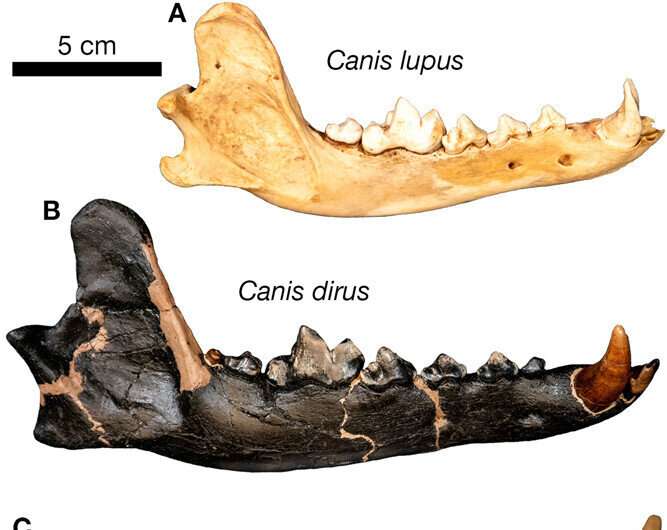April 11, 2023 report
This article has been reviewed according to Science X's editorial process and policies. Editors have highlighted the following attributes while ensuring the content's credibility:
fact-checked
peer-reviewed publication
trusted source
proofread
Canadian dire wolf fossil formally identified

A toothy grinned monster was lurking in the basement collection of a museum in Canada: The fossilized jaw of a beast that once roamed the bluffs along the South Saskatchewan River, competing with saber-toothed cats (Smilodon) in hunting horses, bison, camels and mammoths.
Researcher Ashley R. Reynolds at the Department of Natural History, Royal Ontario Museum, Toronto, decided to examine some past finds more closely with the benefit of new knowledge accrued since the time of the discovery. This practice gained renewed popularity in collections around the world during the pandemic lockdown and has led to many interesting discoveries, including the work Reynolds has published in the Journal of Quaternary Science.
Previous efforts by Reynolds and colleagues had turned up the first evidence of a Canadian saber-toothed cat (Smilodon fatalis) in the museum collection. In the current study, "Dire wolf (Canis dirus) from the late Pleistocene of southern Canada (Medicine Hat, Alberta)," Reynolds analyzed more fossil material from the same excavation site to formally identify a dire wolf from a fossilized jaw bone in the collection.
The fossil, originally found in 1969, was identified as a dire wolf by C. S. Churcher (an author in the current paper) in an unpublished report to the Geological Survey of Canada in 1970, based on its large size. It has never been illustrated or described in detail to confirm the initial identification.
Dire wolves are a larger, extinct canid cousin of the gray wolf with more muscular builds and with more powerful jaws. Three species of dire wolf ranged from North and South America to Eastern China. They must have been a fierce competitor because their territory ranges often overlapped with other large predators, most frequently saber-toothed cats three times their size.
It is unusual that the jaw went unstudied for so long as the specimen would be the first and only dire wolf found in Canada and the northernmost known occurrence of the species by 500 km. It could be that because it was such an outlier that the initial observations lacked confidence for more formal identification.
There is some difficulty in distinguishing between a gray wolf and a dire wolf from a poorly preserved fossil because the two are so closely alike morphologically, despite estimations that the two are separated from having a common ancestor by over 5.5 million years.
With a complete fossil jaw in good condition, the identification would have been straightforward, as the size and distinct patterns on teeth can clearly separate the two. The fossil found in 1969 was in bad shape, fractured in multiple places and missing the more obvious clues on teeth surfaces because some teeth were missing, and the teeth that were preserved with the jaw either preserved poorly or were naturally worn down by a wolf in advanced age.
Without the more obvious identifiers, the researchers took multiple measurements and plotted them against known dire wolf fossils, modern-day gray wolves and gray wolf ancestor fossils. In the analysis there was some overlap with outliers between dire wolves and the gray wolf ancestors, but the plots of the fossilized jaw placed it firmly in the dire wolf category as originally suggested in the 1970 unpublished report. Radiocarbon-dated wood pieces believed to be from near where the jaw was found date to around 45,000 years ago.
The study is a long overdue investigation, adding to the known range of territories the dire wolf inhabited. The recent identification of a 40,000-year-old dire wolf fossil in North East China, cited in the paper, also hints at faunal migrations around the timeframe of the Canadian dire wolf, suggesting it crossed land bridge formations between Asia and North America leading up to the last ice age. As the dire wolves may have lived as recently as 9,500 years ago, it is possible that they crossed paths with early humans migrating into Beringia.
More information: Ashley R. Reynolds et al, Dire wolf ( Canis dirus ) from the late Pleistocene of southern Canada (Medicine Hat, Alberta), Journal of Quaternary Science (2023). DOI: 10.1002/jqs.3516
Journal information: Journal of Quaternary Science
© 2023 Science X Network



















